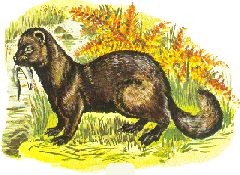
 American
Mink (Minc Mheiriceanách) --:
American
Mink (Minc Mheiriceanách) --:
The American mink is from North America but has settled in the wild in
Ireland, having escaped from mink farms all over the country. The mink is a small mammal with a long body and short
legs. Minks weigh up to 1 kilogram. They can grow to about 50 or 65
centimetres in length. Wild minks have brown fur. There are two kinds of
minks; one is the European and the other is the North American mink. The
European mink is a bit smaller than the North American mink.
Minks live near rivers, streams and lakes. They hunt in water and
on land. Minks were first brought to Ireland from North America for
breeding in fur farms about 40 years ago. By the late 1960’s there were
over 20 mink farms in Ireland, scattered throughout the country. Some of
these captive mink escaped into the wild and became feral or wild.
Female minks give birth in the
month of April, usually and have between four to six babies at a time.
They give birth in the spring. The nest or lair can be found in hollow
trees under tree roots, under rocks or in old nests. By the end of their
first summer, the young can feed themselves, and after 12 months they have
established their hunting territories and they can reproduce their own
family. Minks rarely live beyond three years. The fur of female minks,
though smaller than those of males, often is more valuable, because they
are less coarse. The mink is a good swimmer and spends much of its time in
rivers. It lives close to fresh water. It is a very good hunter and climbs
well.
American mink are raised in
captivity on mink farms in many parts of the world. In northern Europe
these have escaped to established wild American mink populations that have
nearly caused the extinction of the European mink. The mink causes a lot
of trouble to farmers who keep hens, as they often attack hen houses at
night. They also eat a lot of young duck or other water birds.
Owen
Whitehouse